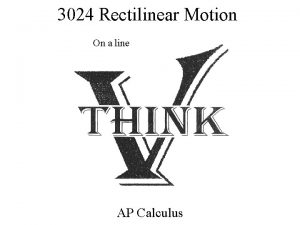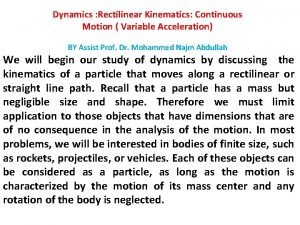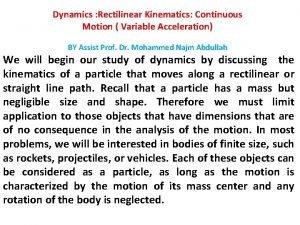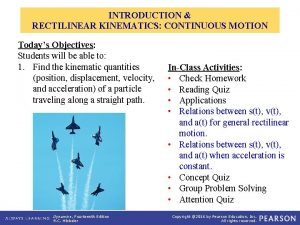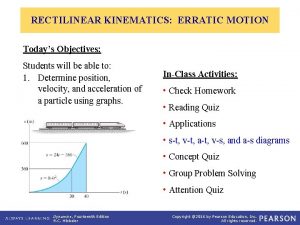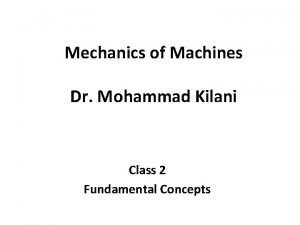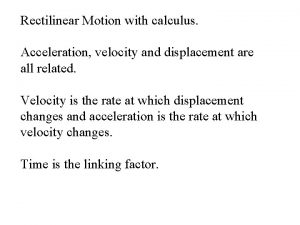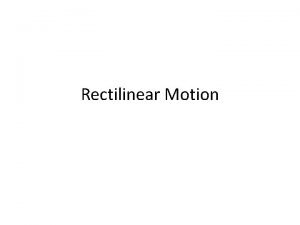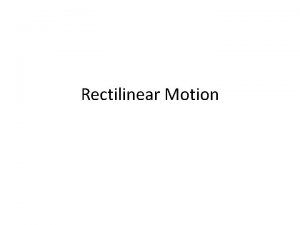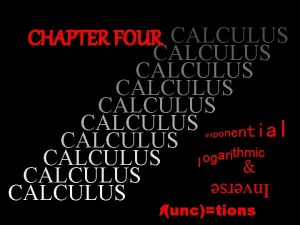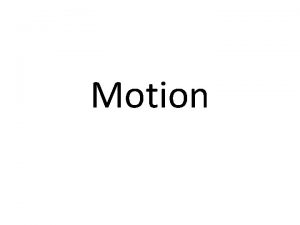3023 Rectilinear Motion AP Calculus Position Defn Rectilinear












- Slides: 12

3023 Rectilinear Motion AP Calculus

Position Defn: Rectilinear Motion: Movement of object in either direction along a coordinate line (x-axis , or y-axis) s(t) = position function - position versus time graph x(t) = horizontal axis (historical note: y(t) = vertical axis a directed distance (a vector quantity) of the particle from some point, p, at instant t. negative time = time before s(t) positive – the particle is____________________ negative – the particle is ____________________ = 0 – the particle is ____________________ _

Velocity v(t) = velocity function - the rate of change of position Velocity gives both quantity of change and direction of change (again a vector quantity) Speed finds quantity only. - absolute value of velocity (a scalar quantity) Rem: Average Velocity = change in position over change in time = = Instantaneous Velocity the derivative

Velocity v(t) = velocity function - the rate of change of position = Instantaneous Velocity the derivative v(t) positive – the particle’s position is __________ < velocity in a positive direction - ____________ negative – the particle’s position is ___________ < velocity in a negative direction - ____________ = 0 - the particle is _______________ {This is the 1 st Derivative Test for increasing /decreasing!}

Acceleration a(t) = acceleration function - rate of change of velocity a(t) positive - velocity is _________________ < acc. in a positive direction – _____________ negative - velocity is _________________ < acc. in neg. direction – _______________ = 0 - velocity is _________________ {This is the 2 nd derivative test for concavity} CAREFUL: This is not SPEEDING UP or SLOWING DOWN!

Speed and Direction Determining changes in Speed speed increasing if v(t) and a(t) have same sign also for v(t) = 0 and a(t) 0 speed decreasing if v(t) and a(t) have opposite signs - Determining changes in Direction direction changes if v(t) = 0 and a(t) 0 no change if both v(t) = 0 and a(t) = 0

Method (General): 1) Find the Critical Numbers in First and Second Derivatives. 1) Answer any questions at specific locations. 2) Do the Number Line Analysis (Brick Wall). 1) Find direction - moving , pushed , and speed 3) Identify the Change of Direction locations 1) Find values at beginning, ending, and change of direction times. 4) Sketch the Schematic graph. 5) Find the Displacement and Total Distance Traveled.

Example: A particle’s position on the y –axis is given by: 1) Find y(t), v(t) and a(t) at t = 2. Interpret each value.

Example: A particle’s position on the y –axis is given by: 2) Determine the motion within each interval: location, direction moving and direction pushed. v(t) a(t) m P s 3) Find the values at t = -3, t = 3 and where the particle changes directions. 4) Find the Displacement and Total Distance Traveled.

Example 2 : A particle’s position on the x –axis is given by: Find and interpret x(t), v(t), and a(t) at t = 5

Example: A particle’s position on the x –axis is given by: v a m p s Sketch:

Last Update • 11/22/10 • Assignment: work sheet - Swokowski
 Rectilinear motion ap calculus
Rectilinear motion ap calculus First position second position third position
First position second position third position Define variable acceleration
Define variable acceleration Variable acceleration definition
Variable acceleration definition Rectilinear kinematics
Rectilinear kinematics Rectilinear motion
Rectilinear motion Rectilinear kinematics: continuous motion
Rectilinear kinematics: continuous motion Rectilinear motion of particles
Rectilinear motion of particles Rectilinear propagation of light
Rectilinear propagation of light Perimeter of rectilinear shapes
Perimeter of rectilinear shapes Rectilinear distance
Rectilinear distance Erratic motion examples with solutions
Erratic motion examples with solutions Grashof
Grashof
